With Bayern München having a true rollercoaster of a season, RB Leipzig stepping up to the very top and Borussia Mönchengladbach surprising friend and foe, several haven't even noticed that Borussia Dortmund is having a pretty rough season. Lucien Favre’s squad has accrued 30 points, 12 fewer than the half-season total they put up prior to last season's winter break. So what’s going on with Die Borussen?
The attack is still solid
A true and reliable striker would be a welcomed improvement for Dortmund. There’s a reason BVB are in the high-profile mix for the winter signing of Red Bull Salzburg’s teen sensation Erling Braut Haaland. Paco Alcácer is the only out-and-out striker in the squad, and the Spaniard does not seem like a permanent solution given his injury woes and unstable form. But even without a genuine striker, and with a manager like Favre with a reputation of being ‘conservative’, Dortmund’s numbers on the attacking side of the ball remain solid. 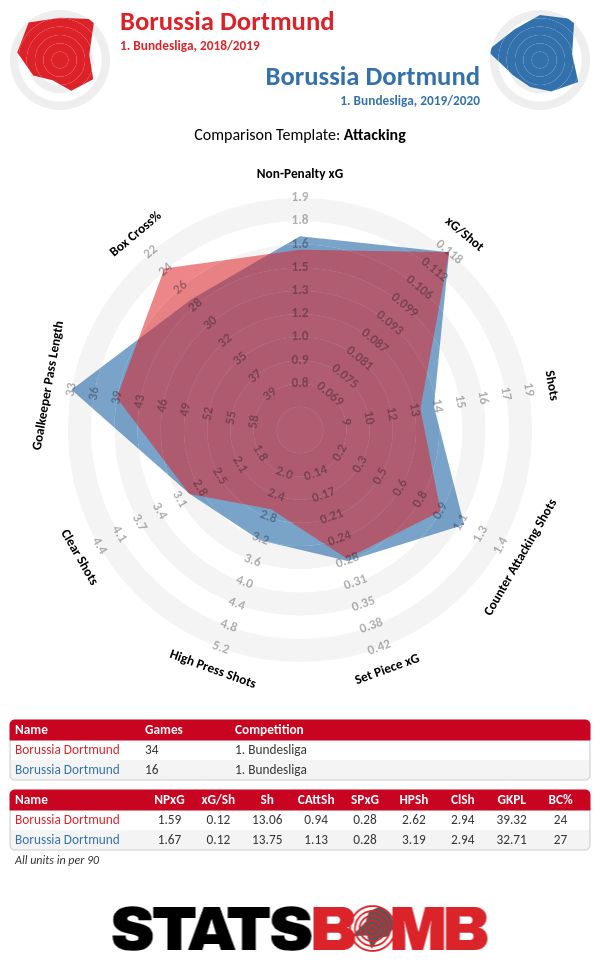 Captain Marco Reus has stepped in as the team’s false nine in recent weeks and provided significant help to the attack. In contrast to the technically gifted, but physically iffy, Mario Götze, Reus combines this important link-up role up top in possession with a scoring threat. The 30-year-old superstar is still so, so good when healthy. Unfortunately, Reus is dealing with a muscle injury during the winter break, and it’s still not entirely clear if he’ll recover in time for the second half of the season.
Captain Marco Reus has stepped in as the team’s false nine in recent weeks and provided significant help to the attack. In contrast to the technically gifted, but physically iffy, Mario Götze, Reus combines this important link-up role up top in possession with a scoring threat. The 30-year-old superstar is still so, so good when healthy. Unfortunately, Reus is dealing with a muscle injury during the winter break, and it’s still not entirely clear if he’ll recover in time for the second half of the season. 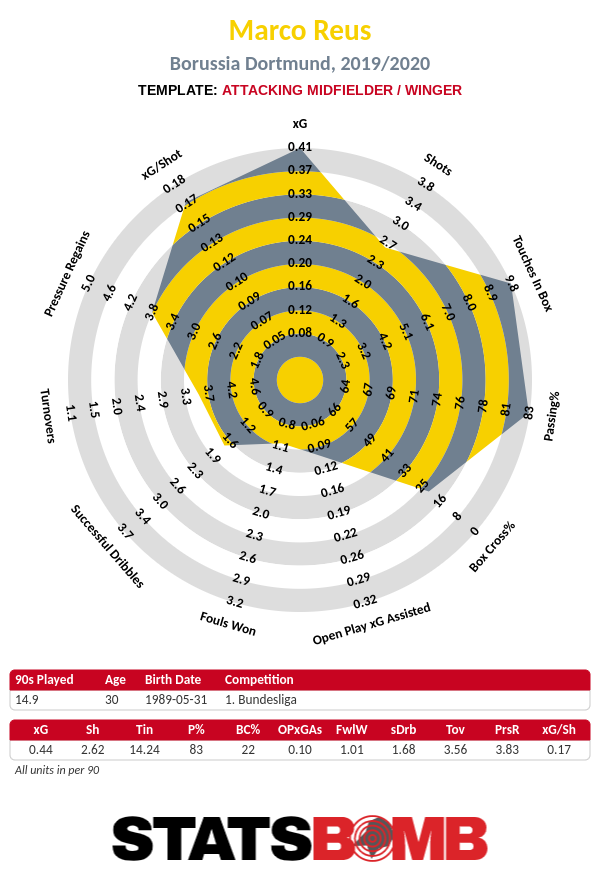 Dortmund’s other offensive star had a rough start to the season. Favre benched Jadon Sancho for disciplinary reasons less than two months ago. But the 19-year-old phenom responded in a major way. In a five-game stretch that started with the November home game against Paderborn (3–3), the English teen scored six and assisted four. Sancho is overperforming in expected goals, but the young winger’s dominance is not dependant on his hot shooting. He is simply the real deal. Dortmund’s short-term future as a legitimate title candidate is linked closely to Sancho’s decision to either stay in Germany or return to an elite Premier League club.
Dortmund’s other offensive star had a rough start to the season. Favre benched Jadon Sancho for disciplinary reasons less than two months ago. But the 19-year-old phenom responded in a major way. In a five-game stretch that started with the November home game against Paderborn (3–3), the English teen scored six and assisted four. Sancho is overperforming in expected goals, but the young winger’s dominance is not dependant on his hot shooting. He is simply the real deal. Dortmund’s short-term future as a legitimate title candidate is linked closely to Sancho’s decision to either stay in Germany or return to an elite Premier League club. 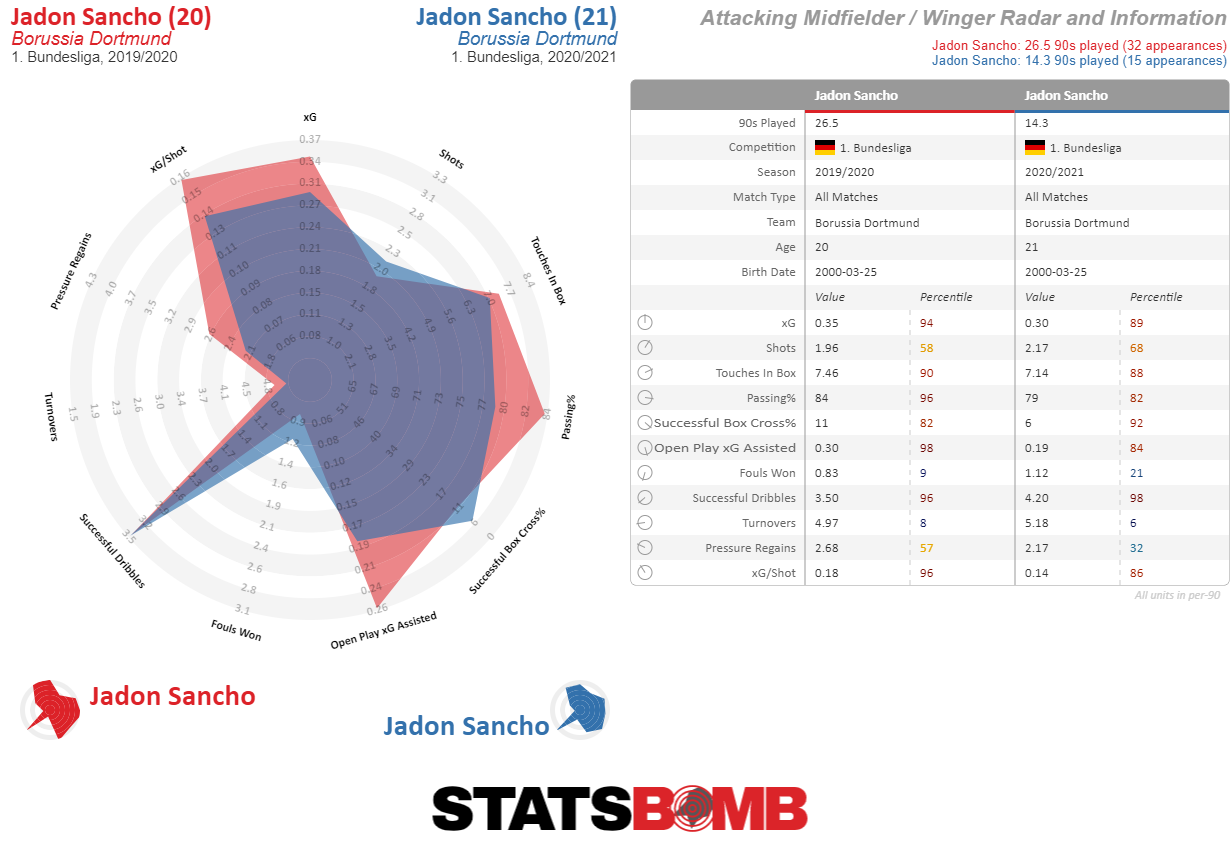 The same can be said for Achraf Hakimi. His two-year loan spell from Real Madrid ends next summer, and it’ll be interesting to see how far Dortmund are willing to go to keep their gifted fullback in-house. With central midfielders Axel Witsel and Thomas Delaney out injured, Favre switched formations to compensate. Due to their lack of defensive midfield options for Favre's favored 4-2-3-1, Dortmund fielded a 3-4-3 formation over the last five games. This elevated Hakimi to the most important player in Dortmund’s build-up, a slippery and creative outlet on the right flank.
The same can be said for Achraf Hakimi. His two-year loan spell from Real Madrid ends next summer, and it’ll be interesting to see how far Dortmund are willing to go to keep their gifted fullback in-house. With central midfielders Axel Witsel and Thomas Delaney out injured, Favre switched formations to compensate. Due to their lack of defensive midfield options for Favre's favored 4-2-3-1, Dortmund fielded a 3-4-3 formation over the last five games. This elevated Hakimi to the most important player in Dortmund’s build-up, a slippery and creative outlet on the right flank. 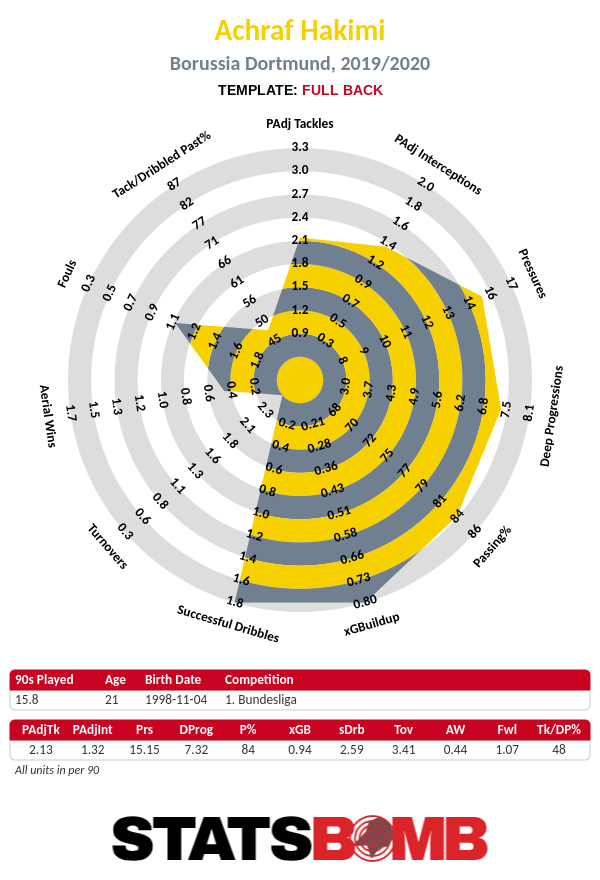
Defensive woes
If we add the last 7 games of Dortmund’s 2018–19 Bundesliga campaign to the numbers they've put up at the midseason mark, Favre’s squad have conceded a whopping total of 40 goals in their last 24 league games. 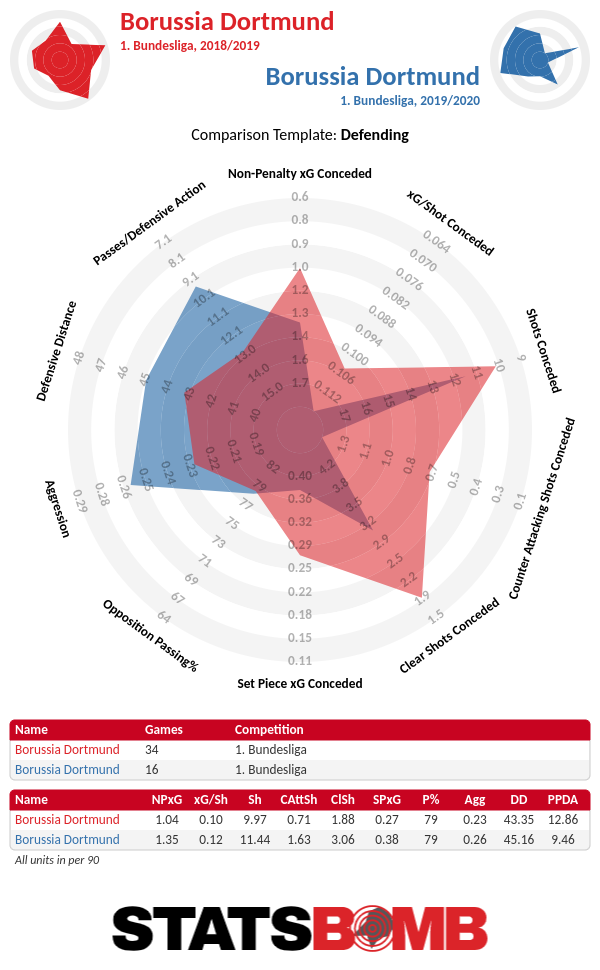 Dortmund made an effort to address that issue this summer with the return of Mats Hummels and the acquisition of Hoffenheim left-back Nico Schulz. And even though the duo has been playing quite well this season, the defense is still slipping.
Dortmund made an effort to address that issue this summer with the return of Mats Hummels and the acquisition of Hoffenheim left-back Nico Schulz. And even though the duo has been playing quite well this season, the defense is still slipping. 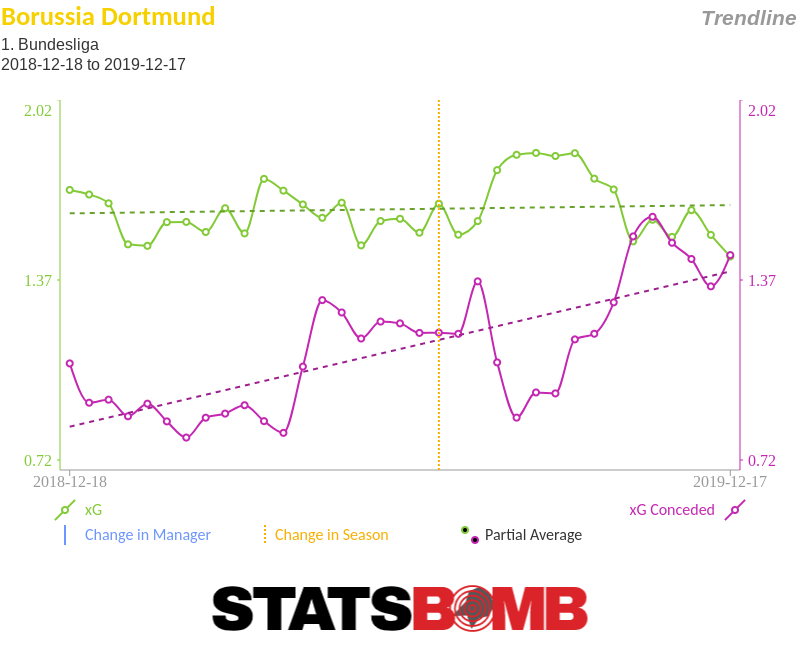 The defensive radars help illustrate Dortmund’s defensive struggles that created the worrisome xG trendline above. Favre’s squad are extremely susceptible to the counter-attack this year, and gave up a bunch more high-quality chances in comparison to last season. Player-wise, Dortmund’s backline lost Abdou Diallo to PSG and gained Hummels and Schulz this season. But form-wise, things have shifted dramatically. Manuel Akanji often looked like a world-class centerback-to-be in his first season and a half at Dortmund, but has become increasingly vulnerable when defending open space this year. The search for an ideal partner for Witsel in defensive midfield has been rocky as well. Before his injury, Delaney was still as good of a ball-winner as last season, but his limitations on the ball hindered Dortmund’s play in possession. Julian Weigl is better as a central midfield hub in the build-up, but starting the 24-year-old in midfield weakens Dortmund’s ability to limit the opposition's counter-attacking opportunities.
The defensive radars help illustrate Dortmund’s defensive struggles that created the worrisome xG trendline above. Favre’s squad are extremely susceptible to the counter-attack this year, and gave up a bunch more high-quality chances in comparison to last season. Player-wise, Dortmund’s backline lost Abdou Diallo to PSG and gained Hummels and Schulz this season. But form-wise, things have shifted dramatically. Manuel Akanji often looked like a world-class centerback-to-be in his first season and a half at Dortmund, but has become increasingly vulnerable when defending open space this year. The search for an ideal partner for Witsel in defensive midfield has been rocky as well. Before his injury, Delaney was still as good of a ball-winner as last season, but his limitations on the ball hindered Dortmund’s play in possession. Julian Weigl is better as a central midfield hub in the build-up, but starting the 24-year-old in midfield weakens Dortmund’s ability to limit the opposition's counter-attacking opportunities. 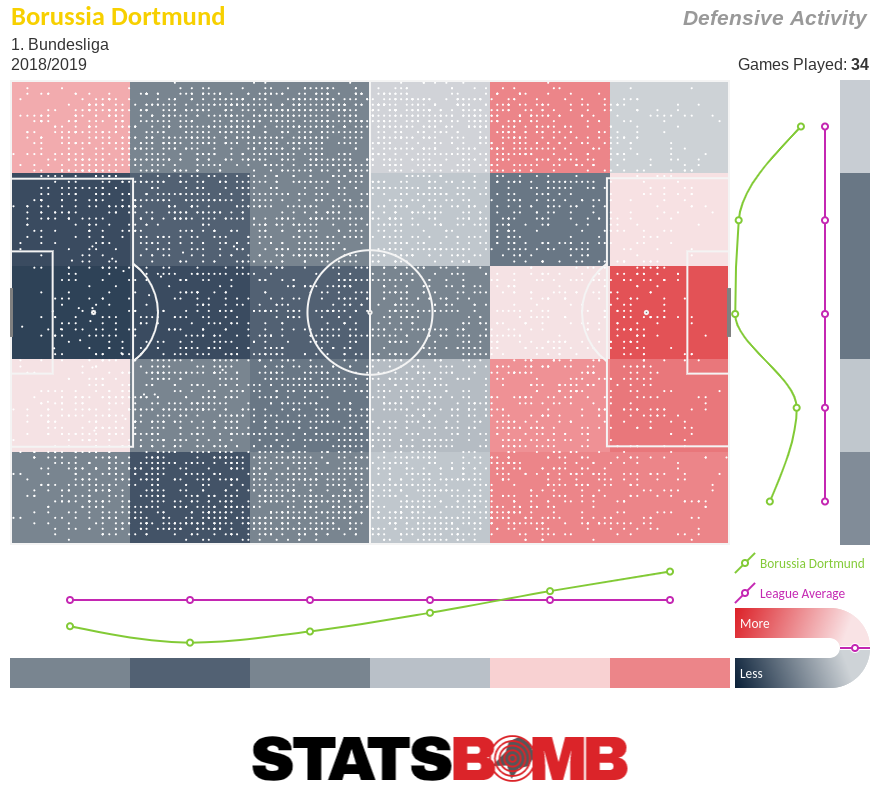 Dortmund’s defensive activity maps from last year (above) and this season (below) show the press has died down a bit and Dortmund are defending more in midfield. Be it at Mönchengladbach or at Nice, Favre has been most successful with teams that are able to drop back and deal a killer blow to the opponent with a swift and precise transition play. But the type of attacking talent (and defensive vulnerabilities) in Dortmund’s squad suggests a high-octane pressing style is a more logical fit.
Dortmund’s defensive activity maps from last year (above) and this season (below) show the press has died down a bit and Dortmund are defending more in midfield. Be it at Mönchengladbach or at Nice, Favre has been most successful with teams that are able to drop back and deal a killer blow to the opponent with a swift and precise transition play. But the type of attacking talent (and defensive vulnerabilities) in Dortmund’s squad suggests a high-octane pressing style is a more logical fit. 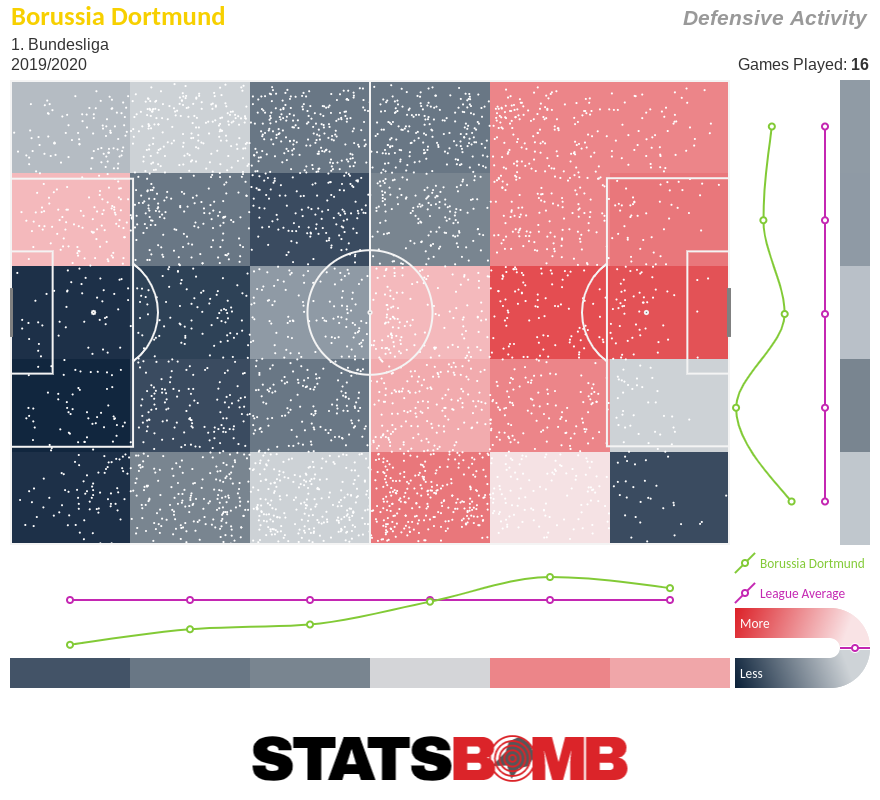 And herein lies the key question for Dortmund. A slight shift in their playing style is needed to lift them up the table. But in which way? Should the squad play more ‘Favresque’, drop a little deeper more often and gamble on the individual prowess of their fast attackers to punish the positional risks the opposition take? Or should Dortmund push harder on the gas pedal and try to outgun the opposition? Even if the Thor Amongst Young Strikers, aka Haaland, signs with Dortmund, Die Borussen have plenty of other issues to solve.
And herein lies the key question for Dortmund. A slight shift in their playing style is needed to lift them up the table. But in which way? Should the squad play more ‘Favresque’, drop a little deeper more often and gamble on the individual prowess of their fast attackers to punish the positional risks the opposition take? Or should Dortmund push harder on the gas pedal and try to outgun the opposition? Even if the Thor Amongst Young Strikers, aka Haaland, signs with Dortmund, Die Borussen have plenty of other issues to solve.